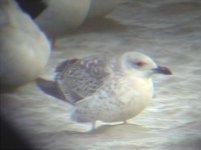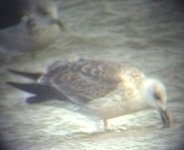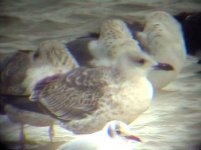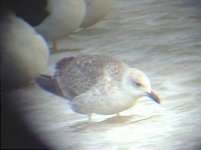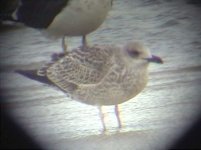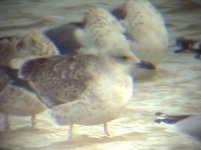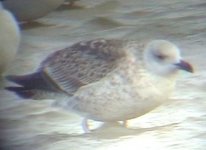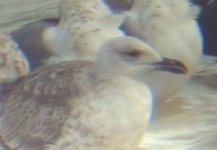Dear all,
I've recently found a video tape that I'd thought to be lost which includes a sequence on the gull in the videograbs. I saw it on 3rd November 2005 and although it gave good views alongside a mix of Lesser Black Backed Gulls and several juv/1w Yellow-Legged Gulls, I couldn't identify it.
It looks like a cross between a Lesser Black Backed Gull and a Yellow Legged Gull to me with the proportions of the Yellow Legged Gull and the greyish-brown mantle of an immature Lesser Black Backed Gull. I believe it to be a juvenile moulting into 1st winter plumage in which case it looks incorrect for a Yellow-Legged Gull (no barring on the mantle) and doesn't have the upperpart markings of a 1st winter Lesser Black Backed Gull either. If it is a 2nd winter Lesser Black Backed Gull, then it wouldn't have the juvenile coverts would it? Maybe things would have been easier if I hadn't rediscovered this video tape at all!
If I'm incorrect in my reasoning (which is quite likely!), could I be shown the error of my ways please.
Thanks,
Lancey
I've recently found a video tape that I'd thought to be lost which includes a sequence on the gull in the videograbs. I saw it on 3rd November 2005 and although it gave good views alongside a mix of Lesser Black Backed Gulls and several juv/1w Yellow-Legged Gulls, I couldn't identify it.
It looks like a cross between a Lesser Black Backed Gull and a Yellow Legged Gull to me with the proportions of the Yellow Legged Gull and the greyish-brown mantle of an immature Lesser Black Backed Gull. I believe it to be a juvenile moulting into 1st winter plumage in which case it looks incorrect for a Yellow-Legged Gull (no barring on the mantle) and doesn't have the upperpart markings of a 1st winter Lesser Black Backed Gull either. If it is a 2nd winter Lesser Black Backed Gull, then it wouldn't have the juvenile coverts would it? Maybe things would have been easier if I hadn't rediscovered this video tape at all!
If I'm incorrect in my reasoning (which is quite likely!), could I be shown the error of my ways please.
Thanks,
Lancey




